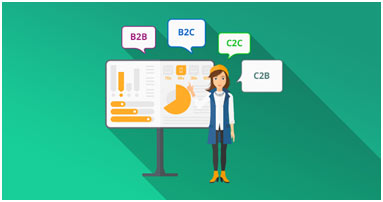Types of E-commerce business models
E-commerce has transformed how people shop today and redefined what is possible. In today's modern age, creative founders find it easy to make their innovative ideas a reality, and every year, we see new e-commerce trends that replace how things were always done.
While the tools of e-commerce businesses are new and rapidly evolving, the basic rules remain the same. This article will discuss the central business models of e-commerce that businesses use to develop their products.
Four types of E-commerce Business Models
Every e-commerce business falls into at least one of the following categories. Each has its benefits and challenges, and most companies simultaneously use several of these categories.

B2C- Business to Consumer
B2C businesses sell directly to their end-user. It is a commonly used business model, and there are many unique approaches under this umbrella.
All the things that we buy in an online store as a consumer are done as B2C transactions, such as household supplies, clothes, bags, etc. B2C is not limited to products but includes services as well.
B2C innovators have focused on technology like mobile apps, advertising, and remarketing directly to their customers to add value to the customer's experience.
In a B2C purchase, the decision-making process is shorter, especially for products of lower value. Due to short sales cycles, B2C businesses spend less on marketing but also have a lower average order value and fewer recurring orders compared to B2B businesses.

B2B- Business to Business
In a B2B business model, a business sells its products or services to other businesses. Sometimes, the buyer is the end-user, but other times the buyer resells to the consumer.
B2B transactions have longer sales cycles but increased order value and recurring purchases.
B2B businesses have replaced catalogs and order sheets with e-commerce storefronts and developed targeting in niche markets.
C2B- Consumer to Business
C2B businesses enable individuals to sell services and goods to companies. Upwork is an early innovator who adopted this model by helping businesses hire freelancers.
The success of C2B e-commerce businesses depends on their competitive edge in pricing for services and goods. This approach allows consumers the power to bid their prices or have businesses compete directly to meet their needs.
Innovators have creatively used the C2B model to connect companies to social media influencers to advertise their products.
C2C- Consumer to Consumer
A C2C business is also referred to as an online marketplace that allows consumers to trade with each other. Two implementations of C2C business models are classified advertisements and auctions.
C2C businesses emerged with e-commerce technology and the sharing economy. C2C marketing has risen in popularity with the advent of the internet and companies such as Etsy, eBay, and Craiglist, which sell services or products through an auction or classified system.
A significant problem that C2C companies face is the lack of quality control and payment guarantees.
Conclusion
We have discussed the four types of business models and their applications. E-commerce has presented every business model with opportunities for innovation and evolution while improving the overall user experience.











